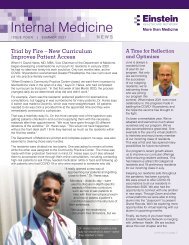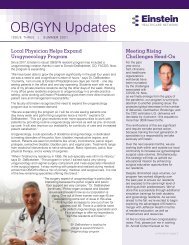Innovations in Cardiology
You also want an ePaper? Increase the reach of your titles
YUMPU automatically turns print PDFs into web optimized ePapers that Google loves.
<strong>Innovations</strong> <strong>in</strong><br />
Cardiovascular<br />
Care<br />
A “Heart-to-Heart” with E<strong>in</strong>ste<strong>in</strong><br />
Sunday | February 9, 2020<br />
FEATURING<br />
Sumeet Ma<strong>in</strong>igi, MD<br />
Raymond S<strong>in</strong>ger, MD<br />
Sean F. Janzer, MD<br />
Alexandra Tuluca, MD<br />
Christian F. Witzke, MD
Meet Sumeet K. Ma<strong>in</strong>igi, MD<br />
How an Operation for Atrial Fibrillation<br />
Changed His Life<br />
Frank Ryan is a 67-year-old retired truck driver,<br />
grandfather of 18 and great-grandfather of 9.<br />
He had been experienc<strong>in</strong>g atrial fibrillation – an<br />
irregular, often rapid heart rhythm that robbed<br />
him of his energy, leav<strong>in</strong>g him weak, lightheaded<br />
and short of breath.<br />
Sumeet K. Ma<strong>in</strong>igi, MD<br />
Chairman of <strong>Cardiology</strong> and Director of Electrophysiology at E<strong>in</strong>ste<strong>in</strong> Medical Center<br />
2<br />
He came to E<strong>in</strong>ste<strong>in</strong> for help. His doctor was Sumeet<br />
Ma<strong>in</strong>igi, MD, Chairman of <strong>Cardiology</strong> and Director of<br />
Electrophysiology at E<strong>in</strong>ste<strong>in</strong> Medical Center. Here is<br />
Frank’s story <strong>in</strong> his own words:<br />
“Dr. Ma<strong>in</strong>igi told me about a revolutionary procedure –<br />
ablation—as a way to treat my atrial fibrillation. He expla<strong>in</strong>ed<br />
the procedure and made me feel confident that I was the<br />
perfect candidate. I said “no.” But one night watch<strong>in</strong>g TV,<br />
I couldn’t focus on the show or relax at all. My heart was<br />
pump<strong>in</strong>g out of my chest. So I decided to do it.<br />
“I woke up after the surgery and knew<br />
someth<strong>in</strong>g was different. I felt like a<br />
new person. Dr. Ma<strong>in</strong>igi gave me my<br />
life back!”<br />
“I’m stronger than ever. I can breathe<br />
better, sleep deeper, and walk longer<br />
distances. I’m able to sit still and<br />
read, which I couldn’t do comfortably<br />
before. I’m even plann<strong>in</strong>g to take my<br />
wife to Ireland next year to celebrate<br />
our 50th wedd<strong>in</strong>g anniversary! Hav<strong>in</strong>g<br />
ablation to repair my rapid heart rate<br />
was the best th<strong>in</strong>g I could have done.<br />
“The folks at E<strong>in</strong>ste<strong>in</strong> really went<br />
the extra mile. I had the greatest doc<br />
on earth. I wouldn’t send anyone to<br />
another hospital.”<br />
by E<strong>in</strong>ste<strong>in</strong> Blog Team<br />
Dr. Ma<strong>in</strong>igi is also an Associate Professor of Medic<strong>in</strong>e at Sidney Kimmel Medical College. He has specific expertise <strong>in</strong> ablation<br />
of atrial fibrillation, ventricular tachycardia, supraventricular tachycardias, and implantation of pacemakers, defibrillators,<br />
and biventricular-devices.<br />
Dr. Ma<strong>in</strong>igi has presented orig<strong>in</strong>al research at many national and <strong>in</strong>ternational scientific meet<strong>in</strong>gs and has authored numerous<br />
publications, book chapters and review articles <strong>in</strong> the fields of cardiology and electrophysiology, <strong>in</strong>clud<strong>in</strong>g a breakthrough catheter<br />
ablation study that has changed the way doctors often treat heart failure. He also serves on several national committees for the<br />
Heart Rhythm Society and American College of <strong>Cardiology</strong>. He is a well-regarded physician and educator and is the recipient of the<br />
follow<strong>in</strong>g awards: Top Doc, Philadelphia Magaz<strong>in</strong>e, 2011 – 2019; Top Doctor Cardiac Electrophysiology, U.S. News & World Report,<br />
2011 – 2018; Top Doctor Under Age of 40 / The Next Generation of Great Philly Docs 2009, Philadelphia Magaz<strong>in</strong>e; E<strong>in</strong>ste<strong>in</strong> Hospital<br />
Teach<strong>in</strong>g Award, E<strong>in</strong>ste<strong>in</strong> Department of Medic<strong>in</strong>e Teach<strong>in</strong>g Award, and E<strong>in</strong>ste<strong>in</strong> Division of <strong>Cardiology</strong> Teach<strong>in</strong>g Award.<br />
Dr. Ma<strong>in</strong>igi holds a degree <strong>in</strong> Biomedical Eng<strong>in</strong>eer<strong>in</strong>g from Johns Hopk<strong>in</strong>s University. He received his medical degree from New York<br />
University (NYU) School of Medic<strong>in</strong>e. He completed his residency <strong>in</strong> <strong>in</strong>ternal medic<strong>in</strong>e, fellowship <strong>in</strong> cardiology, and fellowship<br />
<strong>in</strong> electrophysiology at the Hospital of the University of Pennsylvania. Dr. Ma<strong>in</strong>igi is a Fellow of the Heart Rhythm Society, Fellow of<br />
the American College of <strong>Cardiology</strong>.<br />
Areas of Interest<br />
Atrial Fibrillation/Atrial Flutter, Defibrillators (ICD’s), Pacemakers, Radiofrequency Ablation, Supraventricular Tachycardia, Syncope,<br />
Ventricular Tachycardia
Meet Raymond L. S<strong>in</strong>ger, MD<br />
Raymond L. S<strong>in</strong>ger, MD, was named Chief of<br />
Cardiac Surgery at E<strong>in</strong>ste<strong>in</strong> Medical Center<br />
Montgomery <strong>in</strong> March 2019.<br />
Previously, he was Physician <strong>in</strong> Chief of the Institute<br />
for Special Surgery at Lehigh Valley Hospital, where he<br />
spent 27 years and performed more than 7,000 surgeries.<br />
Dr. S<strong>in</strong>ger is a fellow of the American College of Surgeons,<br />
the Society of Thoracic Surgery, the American College of<br />
<strong>Cardiology</strong>, and the American College of Chest Physicians<br />
and a past president of the Pennsylvania Association for<br />
Thoracic Surgery.<br />
Q: How did you decide to become a doctor?<br />
A: Ever s<strong>in</strong>ce I was young, I wanted to be a physician.<br />
In fact, there are reels of silent 8-millimeter movies<br />
from the 1960s show<strong>in</strong>g me with my play doctor’s kit,<br />
exam<strong>in</strong><strong>in</strong>g everyone <strong>in</strong> the family.<br />
Q: What drew you to your specialty?<br />
A: Orig<strong>in</strong>ally, I was <strong>in</strong>terested <strong>in</strong> be<strong>in</strong>g a family physician.<br />
I guess I was <strong>in</strong>fluenced by some of the TV shows of<br />
the late 1960s. I had applied to the brand-new medical<br />
school <strong>in</strong> Hershey because there was a newspaper<br />
article <strong>in</strong> the Philadelphia Bullet<strong>in</strong> say<strong>in</strong>g they were<br />
go<strong>in</strong>g to be creat<strong>in</strong>g country docs. I just pictured<br />
I would live <strong>in</strong> the country and get a big dog.<br />
I got accepted at Hershey and then, lo and behold,<br />
I got accepted to the University of Pennsylvania.<br />
They didn’t really have a family practice track. Next<br />
th<strong>in</strong>g I know I was hang<strong>in</strong>g out with surgeons and<br />
found it very exhilarat<strong>in</strong>g to be able to <strong>in</strong>tervene <strong>in</strong><br />
somebody’s life <strong>in</strong> such a dramatic fashion, particularly<br />
with heart surgery. And so sometimes I th<strong>in</strong>k of myself<br />
as be<strong>in</strong>g a family doctor on the <strong>in</strong>side and a surgeon<br />
on the outside.<br />
Q: Where did you receive your tra<strong>in</strong><strong>in</strong>g?<br />
A: When I f<strong>in</strong>ished medical school, I did my tra<strong>in</strong><strong>in</strong>g <strong>in</strong><br />
general surgery and cardiothoracic surgery at Thomas<br />
Jefferson University Hospital. That was eight years:<br />
five years <strong>in</strong> general surgery and three years <strong>in</strong> cardiac<br />
surgery. I did additional tra<strong>in</strong><strong>in</strong>g <strong>in</strong> Paris with Dr. Ala<strong>in</strong><br />
Carpentier to learn advanced techniques <strong>in</strong> mitral valve<br />
repair surgery, as well as <strong>in</strong> Belgium with Dr. Hugo<br />
Vanermen and <strong>in</strong> London under Dr. Magdi Yocoub.<br />
Q: You’re a cardiothoracic surgeon. In layman’s terms,<br />
what does that mean? What k<strong>in</strong>d of conditions do<br />
you treat?<br />
A: We are tra<strong>in</strong>ed to do heart and lung surgery. In fact,<br />
I started a website <strong>in</strong> 1999 called heartlungdoc.com.<br />
At E<strong>in</strong>ste<strong>in</strong> Montgomery, my focus is heart surgery.<br />
With heart surgery, we deal with heart valve disease<br />
and coronary artery disease primarily. We also perform<br />
complex aortic aneurysm surgery.<br />
In addition to the conventional valve and bypass<br />
procedures, we also perform less <strong>in</strong>vasive procedures,<br />
rang<strong>in</strong>g from small <strong>in</strong>cision “keyhole” operations us<strong>in</strong>g<br />
telescopes, to trans-catheter procedures to repair and/<br />
or replace faulty aortic and mitral valves. It’s excit<strong>in</strong>g<br />
to work at E<strong>in</strong>ste<strong>in</strong> because of the collaborative efforts<br />
of the cardiologists and surgeons, work<strong>in</strong>g together<br />
to get our patients back to their normal lives as soon<br />
as possible.<br />
Q: Can you expla<strong>in</strong> a little bit about the transcatheter<br />
aortic valve replacement procedure, or TAVR?<br />
A: Currently, the TAVR procedure is used for aortic<br />
stenosis, which means that the patient’s aortic<br />
valve is restricted from open<strong>in</strong>g, typically due to the<br />
development of calcium deposits on the valve. In the<br />
TAVR procedure, we do not open the chest and we<br />
do not use the heart-lung mach<strong>in</strong>e. We don’t stop the<br />
heart. We’re able to do about 90% of them just from<br />
catheters <strong>in</strong> the gro<strong>in</strong>, like a cardiac catheterization<br />
procedure. Us<strong>in</strong>g x-ray guidance, we can place a new<br />
valve <strong>in</strong>side the patient’s own valve, push<strong>in</strong>g aside the<br />
calcium deposits with a stent. Most patients can go<br />
home <strong>in</strong> just a day or two after a TAVR procedure.<br />
Q: Can anyone with aortic stenosis get the valve<br />
replaced with the TAVR procedure <strong>in</strong>stead of<br />
open-heart surgery?<br />
A: In order to have a TAVR, you need to be either<br />
high risk or what they call <strong>in</strong>termediate risk patients.<br />
I was among the first <strong>in</strong> the country to do the TAVR<br />
procedure <strong>in</strong> 2012, and I was a pr<strong>in</strong>cipal <strong>in</strong>vestigator for<br />
what is known as the low-risk TAVR trial. We anticipate<br />
this spr<strong>in</strong>g or summer that the FDA will approve this<br />
technology for patients who are low risk.<br />
(cont<strong>in</strong>ued on next page)<br />
The Sumeet K. Ma<strong>in</strong>igi, MD article on page 2 appeared <strong>in</strong> E<strong>in</strong>ste<strong>in</strong> Healthcare Network’s Perspectives blog.<br />
To access the blog and more <strong>in</strong>formation about network services, please visit www.e<strong>in</strong>ste<strong>in</strong>.edu.<br />
3
Q: You came to E<strong>in</strong>ste<strong>in</strong> recently from Lehigh Valley<br />
Hospital. What drew you here?<br />
A: I grew up down here. I went to Cheltenham High<br />
School and my wife went to Plymouth-Whitemarsh. So,<br />
this is home for us. E<strong>in</strong>ste<strong>in</strong> is an extraord<strong>in</strong>ary place<br />
with excellent care. I’m particularly drawn to E<strong>in</strong>ste<strong>in</strong><br />
Montgomery, where there is a feel<strong>in</strong>g of warmth and<br />
car<strong>in</strong>g, along with state-of-the-art technology and highly<br />
tra<strong>in</strong>ed and experienced doctors and nurses. I feel<br />
that E<strong>in</strong>ste<strong>in</strong> Montgomery is a real gem and I’m thrilled<br />
to be home and to be able to make a difference <strong>in</strong> that<br />
community where I grew up. My dream is that <strong>in</strong> only a<br />
short time, the good people of our community will ask a<br />
simple question, “Why would I go anywhere else for my<br />
care than E<strong>in</strong>ste<strong>in</strong> Montgomery?”<br />
Q: Do you have a favorite book?<br />
A: I’ve always enjoyed read<strong>in</strong>g Dr. Wayne Dyer’s books<br />
and listen<strong>in</strong>g to his lectures on health and wellness.<br />
Two additional books that have great mean<strong>in</strong>g to me<br />
are Tom Brokaw’s The Greatest Generation and Mitch<br />
Albom’s Have a Little Faith.<br />
Q: Favorite hobby?<br />
A: My favorite hobby is play<strong>in</strong>g piano and s<strong>in</strong>g<strong>in</strong>g. I’ve<br />
played the piano s<strong>in</strong>ce I was very young, and I’ve<br />
enjoyed theater and play<strong>in</strong>g keyboard and s<strong>in</strong>g<strong>in</strong>g<br />
<strong>in</strong> bands. My favorite role <strong>in</strong> a play was Don Quixote<br />
<strong>in</strong> The Man of La Mancha. I also helped pay my way<br />
through college and medical school by work<strong>in</strong>g as a<br />
disc jockey.<br />
Q: Favorite movie?<br />
A: No doubt, it’s Field of Dreams. For one th<strong>in</strong>g, it was the<br />
first date I had with my wife, and I’m also a big baseball<br />
fan. I can remember my father tak<strong>in</strong>g me to Connie<br />
Mack Stadium as a boy. My two daughters now love<br />
go<strong>in</strong>g to Phillies games with me.<br />
Q: What is someth<strong>in</strong>g that people might not know<br />
about you?<br />
A: I’ve often said I come from a family of patients, not a<br />
family of doctors. Both my parents worked so hard to<br />
give me the opportunities <strong>in</strong> life that they never enjoyed.<br />
They survived the Great Depression and World<br />
War II. Both my parents had cancer and heart disease.<br />
I’ve sat <strong>in</strong> many doctors’ offices and surgical wait<strong>in</strong>g<br />
rooms, pray<strong>in</strong>g for their recovery. I know what it feels<br />
like to be on the other side, so I try my best to always<br />
treat my patients and my colleagues as if they were my<br />
own family.<br />
by Lisa Ellis for E<strong>in</strong>ste<strong>in</strong> Perspectives<br />
Raymond S<strong>in</strong>ger, MD<br />
Chief of Cardiac Surgery at E<strong>in</strong>ste<strong>in</strong> Medical Center Montgomery<br />
As a board-certified cardiothoracic surgeon, Dr. S<strong>in</strong>ger has<br />
completed more than 7,000 heart and lung operations s<strong>in</strong>ce<br />
complet<strong>in</strong>g his general surgery and cardiothoracic residencies<br />
at Thomas Jefferson University Hospital.<br />
Dr. S<strong>in</strong>ger received his medical degree from the University of<br />
Pennsylvania School of Medic<strong>in</strong>e and a Master’s <strong>in</strong> Medical<br />
Management from Carnegie Mellon University at the H. John<br />
He<strong>in</strong>z III School of Public Policy and Management. He is a<br />
past-president of the Pennsylvania Association for Thoracic<br />
Surgery and is a nationally known healthcare leader. Dr. S<strong>in</strong>ger<br />
has a passion for surgical excellence and is recognized for his<br />
quality outcomes and personalized care.<br />
He is a member of the American College of Surgeons,<br />
American College of <strong>Cardiology</strong>, American College of Chest<br />
Physicians, American College of Physician Executives and<br />
Society of Thoracic Surgeons.<br />
Orig<strong>in</strong>ally appeared <strong>in</strong> E<strong>in</strong>ste<strong>in</strong> Healthcare Network’s<br />
Perspectives blog. To access the blog and more <strong>in</strong>formation<br />
about network services, please visit www.e<strong>in</strong>ste<strong>in</strong>.edu.<br />
4
Meet Sean F. Janzer, MD<br />
Patient Comes From New Zealand for<br />
Procedures to Boost Blood Flow <strong>in</strong> Legs<br />
In some ways, Simon Willis Webb is a typical<br />
patient of Dr. Sean Janzer – he sought treatment<br />
for pa<strong>in</strong>ful blocked arteries <strong>in</strong> his legs that forced<br />
him to curtail his activities.<br />
In some ways, though, Webb is anyth<strong>in</strong>g but typical – he<br />
came from New Zealand to see Dr. Janzer, an <strong>in</strong>terventional<br />
cardiologist at E<strong>in</strong>ste<strong>in</strong> Medical Center Philadelphia.<br />
Webb is a successful entrepreneur <strong>in</strong> his 60s who lives <strong>in</strong><br />
the North Island of New Zealand, <strong>in</strong> Hamilton, and loves<br />
spend<strong>in</strong>g time outdoors. But he was struggl<strong>in</strong>g to ski, bike<br />
and hike because the major arteries <strong>in</strong> both of his legs<br />
were clogged.<br />
Peripheral artery disease is a progressive disease that<br />
is the result of plaque buildup <strong>in</strong> the arteries that supply<br />
blood to the limbs. It affects up to 8.5 million people <strong>in</strong><br />
the United States alone.<br />
In New Zealand, Webb had undergone angioplasty, <strong>in</strong><br />
which balloons were used to open his femoral arteries,<br />
the ma<strong>in</strong> vessels that supply blood to the legs. But that<br />
procedure was unsuccessful.<br />
He cont<strong>in</strong>ued to exercise to help develop peripheral blood<br />
vessels <strong>in</strong> his legs to improve circulation. “I worked very<br />
hard at keep<strong>in</strong>g my legs fit and strong,” he says. “I did this<br />
by walk<strong>in</strong>g every day as well as rid<strong>in</strong>g my bike and ski<strong>in</strong>g as<br />
often as possible. But these activities with blocked arteries<br />
took a lot of effort and a certa<strong>in</strong> amount of suffer<strong>in</strong>g.”<br />
One day, while Webb was search<strong>in</strong>g the <strong>in</strong>ternet for a better<br />
solution to his health problem, he discovered a technique<br />
called the Av<strong>in</strong>ger Pantheris Lumivascular Atherectomy.<br />
(cont<strong>in</strong>ued on next page)<br />
5
This form of atherectomy, <strong>in</strong> which a catheter with a sharp<br />
blade is used to remove plaque from a blood vessel,<br />
wasn’t available <strong>in</strong> New Zealand. The procedure allows<br />
the surgeon to see <strong>in</strong>side the artery through a camera,<br />
so that the extraction of the plaque can be more precise.<br />
Webb eventually found a video of Dr. Janzer perform<strong>in</strong>g<br />
the procedure. “I already liked the sound of Dr. Janzer<br />
and respected his skill and abilities from his video presentation,”<br />
he says. “After check<strong>in</strong>g his profile on several sites,<br />
I could see that he was greatly respected by his peers and<br />
his patients alike.”<br />
Dr. Janzer has been the primary <strong>in</strong>vestigator on research<br />
projects of the devices and tra<strong>in</strong>s other physicians on<br />
how to use them. When Webb contacted him and sent<br />
diagnostic studies of his legs, Dr. Janzer gave him hope.<br />
“I said I could do someth<strong>in</strong>g,” Webb says.<br />
Webb flew to the United States <strong>in</strong> November <strong>in</strong> the<br />
company of his son to undergo the first procedure on his<br />
left leg. The improvement was immediate. “I now have a<br />
strong pulse <strong>in</strong> my foot, which could not be felt prior to<br />
surgery,” he said at the time. “My left leg is way better<br />
than it was.”<br />
Webb and his son then flew to Florida to go sightsee<strong>in</strong>g.<br />
It was his first trip to the United States for medical reasons,<br />
but his third as a tourist. “We loved Miami and its sunsh<strong>in</strong>e,”<br />
he says, “but we both believe Philadelphia has way more<br />
character and genu<strong>in</strong>eness. We love its history and friendly<br />
people.”<br />
Then Webb returned to E<strong>in</strong>ste<strong>in</strong> for the procedure on his<br />
right leg on December 5 and soon returned home. “His<br />
second procedure went well,” Dr. Janzer says. The doctor<br />
and the patient have become friends, and Dr. Janzer is<br />
plann<strong>in</strong>g to visit Webb <strong>in</strong> New Zealand <strong>in</strong> the next year.<br />
“I wondered at times if I should be do<strong>in</strong>g this,” Webb says<br />
of his trip across the ocean for treatment at E<strong>in</strong>ste<strong>in</strong>. “But<br />
I just love to be physical and believed that improvement<br />
would be worth it. The surgeries have given me a better<br />
quality of life and made me feel happier about my life.<br />
“I cannot speak highly enough of the people at E<strong>in</strong>ste<strong>in</strong>,”<br />
he says. “They have welcomed me with open arms and<br />
made sure that my every comfort and need has been met.<br />
They are extremely professional, and I would recommend<br />
them to anyone who asked.”<br />
by Jill Porter for E<strong>in</strong>ste<strong>in</strong> Perspectives<br />
Orig<strong>in</strong>ally appeared <strong>in</strong> E<strong>in</strong>ste<strong>in</strong> Healthcare Network’s Perspectives<br />
blog. To access the blog and more <strong>in</strong>formation about network<br />
services, please visit www.e<strong>in</strong>ste<strong>in</strong>.edu.<br />
Sean F. Janzer, MD<br />
Program Director, Interventional <strong>Cardiology</strong> Fellowship<br />
E<strong>in</strong>ste<strong>in</strong> Medical Center Philadelphia<br />
Dr. Sean Janzer is an <strong>in</strong>terventional cardiologist with nearly thirty<br />
years of experience. He completed his medical degree at Drexel<br />
University (then known as Hahnemann Medical College) and <strong>in</strong>ternal<br />
medic<strong>in</strong>e <strong>in</strong>ternship and residency at Drexel University Hospital<br />
(formerly Hahnemann University Hospital). It was there where he also<br />
completed his fellowship <strong>in</strong> cardiology and <strong>in</strong>terventional cardiology.<br />
He is board certified by the American Board of Internal Medic<strong>in</strong>e<br />
and Subspecialty Board of Cardiovascular Disease and Interventional<br />
<strong>Cardiology</strong> and is an Endovascular Diplomat of the<br />
American Board of Vascular Medic<strong>in</strong>e. He has lectured, written and<br />
published nationally and <strong>in</strong>ternationally <strong>in</strong> his area of expertise<br />
which <strong>in</strong>cludes advanced, m<strong>in</strong>imally <strong>in</strong>vasive treatments for heart<br />
and vascular conditions, <strong>in</strong>clud<strong>in</strong>g Peripheral Artery Disease (PAD),<br />
Critical Limb Ischemia, and coronary artery Chronic Total Occlusions<br />
(CTO) and the latest treatments for Peripheral Artery Disease (PAD).<br />
As an educator and Director of E<strong>in</strong>ste<strong>in</strong>’s <strong>Cardiology</strong> Fellowship,<br />
he is tra<strong>in</strong><strong>in</strong>g the next generation of <strong>in</strong>terventional cardiologists.<br />
As Pr<strong>in</strong>cipal Investigator for national research studies, he is lead<strong>in</strong>g<br />
the way <strong>in</strong> def<strong>in</strong><strong>in</strong>g the best treatment protocols to improve outcomes<br />
for cardiac patients. He is recipient of numerous professional<br />
accolades <strong>in</strong>clud<strong>in</strong>g be<strong>in</strong>g named a Philadelphia Magaz<strong>in</strong>e<br />
“Top Doc” on multiple occasions and a six-year consecutive run<br />
as a “top doc” by U.S. News & World Report and Castle Connolly.<br />
Areas of Interest<br />
Cardiac Catheterization, Cardiovascular Diseases,<br />
Chronic Total Occlusions<br />
6
Meet Alexandra Tuluca, MD<br />
Alexandra Tuluca, MD, the Associate<br />
Chief of Cardiac Surgery, is a busy<br />
attend<strong>in</strong>g cardiothoracic surgeon for<br />
E<strong>in</strong>ste<strong>in</strong> Healthcare Network.<br />
She is one of only a handful of female heart surgeons <strong>in</strong><br />
the country and is a recent recipient of a “40 under 40”<br />
award by the Pennsylvania Medical Society. Her <strong>in</strong>terests<br />
<strong>in</strong>clude m<strong>in</strong>imally <strong>in</strong>vasive cardiac surgery, the treatment<br />
of aortic disease, and endovascular surgery.<br />
We sat down with her recently to talk about her career,<br />
discover<strong>in</strong>g some of the steps along the way that led to<br />
her time and cl<strong>in</strong>ical <strong>in</strong>terests at E<strong>in</strong>ste<strong>in</strong>.<br />
Q: You’re a cardiothoracic surgeon. In layman’s terms,<br />
what does that mean? What k<strong>in</strong>d of conditions do<br />
you treat?<br />
A: In layman’s terms it means I’m a heart surgeon.<br />
I perform procedures that relate to the heart, such<br />
as coronary artery bypass surgery, valve repair or<br />
replacement, and aortic aneurysm surgery. Of course,<br />
with<strong>in</strong> each of those categories there are further<br />
subtleties. In heart valves, for example, there’s<br />
m<strong>in</strong>imally <strong>in</strong>vasive valve work that can be done<br />
through “m<strong>in</strong>i-<strong>in</strong>cisions” as well as percutaneously.<br />
Specifically, I perform a percutaneous treatment<br />
called TAVR (transcatheter aortic valve replacement)<br />
<strong>in</strong> high volume here at E<strong>in</strong>ste<strong>in</strong>.<br />
Q: In a lot of ways, some of that really seems new,<br />
compared to how it was done <strong>in</strong> the past.<br />
A: Yes, cardiac surgery as a field is rapidly evolv<strong>in</strong>g.<br />
I th<strong>in</strong>k the traditional th<strong>in</strong>k<strong>in</strong>g about heart surgery is<br />
that all the patients that get surgery are <strong>in</strong>credibly sick<br />
and stay <strong>in</strong> the hospital for weeks or even months.<br />
That’s really not the case and is largely a th<strong>in</strong>g of the<br />
past. Many times, heart surgery is actually quite safe.<br />
I would say our success rates are very high. Patients<br />
go home, on average, between four and five days after<br />
surgery. We have also made a lot of advances <strong>in</strong> the<br />
m<strong>in</strong>imally-<strong>in</strong>vasive realm. At E<strong>in</strong>ste<strong>in</strong>, we probably do<br />
a lot more m<strong>in</strong>imally-<strong>in</strong>vasive surgery for isolated valve<br />
and bypass procedures than other places <strong>in</strong> the city.<br />
Not everyone can do it.<br />
Q: What drew you to your specialty?<br />
A: I have wanted to be a surgeon, literally, s<strong>in</strong>ce I was<br />
about 4 years old. My grandfather was a surgeon <strong>in</strong><br />
a small town. He was surgeon-<strong>in</strong>-chief at one of the<br />
two major hospitals.<br />
I still remember specifically how my grandfather<br />
affected the lives of his patients. As an example,<br />
I remember how we would walk down the street and<br />
people would just stop him and say, “Oh, Dr. Tuluca,<br />
do you remember me? You operated on me and saved<br />
my life!” All of those types of memories just resonate<br />
with me. I always remember them and have not veered<br />
from that. I th<strong>in</strong>k my entire life I just wanted to be a<br />
surgeon as I was so <strong>in</strong>spired by my grandfather.<br />
Dur<strong>in</strong>g my second year of surgery residency,<br />
I remember see<strong>in</strong>g a complex heart operation and that<br />
was it. I remember say<strong>in</strong>g to myself, “This is what I’m<br />
go<strong>in</strong>g to do.” Fast forward years later and I am do<strong>in</strong>g<br />
what I love.<br />
Heart surgery is a very excit<strong>in</strong>g field. We’ve made a<br />
lot of progress <strong>in</strong> short amount of time. When you put<br />
th<strong>in</strong>gs <strong>in</strong> perspective, the field of cardiac surgery itself<br />
didn’t truly start until the 1950s. That means it has<br />
been less than 100 years s<strong>in</strong>ce we’ve been do<strong>in</strong>g<br />
such complex procedures, even globally! So, to go<br />
from not even hav<strong>in</strong>g a heart-lung mach<strong>in</strong>e at the very<br />
beg<strong>in</strong>n<strong>in</strong>g to now do<strong>in</strong>g many operations through<br />
smaller <strong>in</strong>cisions or through catheter and wire-based<br />
percutaneous procedures, it surely is a field that is<br />
constantly evolv<strong>in</strong>g.<br />
There’s def<strong>in</strong>itely a technical aspect of these<br />
surgeries that I enjoy, but what is most satisfy<strong>in</strong>g for<br />
me is to make such a difference <strong>in</strong> patients’ quality<br />
of life. I have patients who see me prior to surgery all<br />
the time who are just miserable. They have chest pa<strong>in</strong><br />
or they haven’t been able to go up a flight of stairs.<br />
They just aren’t able to live their life to the fullest, and<br />
then you do a surgery, guide them safely through,<br />
and often immediately after they say they can breathe<br />
better, feel better, and have more energy. It’s just<br />
<strong>in</strong>credibly reward<strong>in</strong>g.<br />
(cont<strong>in</strong>ued on next page)<br />
7
Q: What drew you to E<strong>in</strong>ste<strong>in</strong>?<br />
A: I tra<strong>in</strong>ed at Temple University for general surgery. I was<br />
raised <strong>in</strong> New Jersey, and went to medical school <strong>in</strong><br />
New Jersey, so I’ve been <strong>in</strong> this area for a while. My<br />
husband, Jay Simhan, also works for E<strong>in</strong>ste<strong>in</strong> as a<br />
surgeon <strong>in</strong> the Urology department; we both were<br />
recruited to E<strong>in</strong>ste<strong>in</strong> at the same time. Although we<br />
were recruited nationally to various cities, we always<br />
loved Philadelphia and loved the mission of E<strong>in</strong>ste<strong>in</strong>.<br />
It just worked out that we both found positions that<br />
we felt would satisfy what we wanted.<br />
Q: What are your cl<strong>in</strong>ical <strong>in</strong>terests?<br />
A: I like to focus my practice on aortic surgery <strong>in</strong> particular.<br />
This <strong>in</strong>cludes m<strong>in</strong>imally-<strong>in</strong>vasive aortic valves,<br />
transcatheter aortic valves, aortic roots, aortic aneurysms,<br />
and endovascular aortic surgery. I am one of<br />
the few surgeons <strong>in</strong> the region with specific tra<strong>in</strong><strong>in</strong>g <strong>in</strong><br />
aortic conditions and I have a fair amount of experience<br />
perform<strong>in</strong>g surgeries with<strong>in</strong> this subspecialty.<br />
Q: So you perform procedures at E<strong>in</strong>ste<strong>in</strong> Medical<br />
Center Montgomery, and you’re also at E<strong>in</strong>ste<strong>in</strong><br />
Medical Center Philadelphia?<br />
A: Yes. This week, I operated at E<strong>in</strong>ste<strong>in</strong> Philadelphia<br />
on Tuesday and Wednesday, and then I operated at<br />
E<strong>in</strong>ste<strong>in</strong> Montgomery on Monday and Thursday.<br />
Q: Do you have a favorite book, or books?<br />
A: I like science fiction. Any sort of sci-fi type book,<br />
dystopian, post-apocalyptic, any Isaac Asimov book,<br />
HG Wells, any old-school sci-fi book, I’ve read it, and<br />
loved it.<br />
Q: Favorite movie?<br />
A: Star Wars. Really, the old Star Wars. We’re go<strong>in</strong>g to<br />
skip the three episodes (Episodes I, II, and III) that<br />
were totally awful, and then the new Star Wars.<br />
I also really, really like the Marvel Universe movies.<br />
I could just watch those movies, when they’re on TV.<br />
Just turn the TV on, “Oh! Capta<strong>in</strong> America!”<br />
Orig<strong>in</strong>ally appeared <strong>in</strong> E<strong>in</strong>ste<strong>in</strong> Healthcare Network’s<br />
Perspectives blog. To access the blog and more <strong>in</strong>formation<br />
about network services, please visit www.e<strong>in</strong>ste<strong>in</strong>.edu.<br />
Q: What is there about you that people might not know?<br />
A: Many people don’t know this, but I was born <strong>in</strong><br />
Romania. I came to the United States as a teenager<br />
at the start of my high school education <strong>in</strong> this<br />
country. Mov<strong>in</strong>g here basically uprooted my entire<br />
life <strong>in</strong> Romania, I came here with my dad to live the<br />
American dream.<br />
by Jeff Meade for E<strong>in</strong>ste<strong>in</strong> Perspectives<br />
Heart Disease Is as American as Apple Pie*<br />
Heart disease cont<strong>in</strong>ues to rise <strong>in</strong> the U.S. Heart surgeon<br />
Dr. Alexandra Tuluca, Associate Chief of Cardiac Surgery<br />
at E<strong>in</strong>ste<strong>in</strong> Healthcare Network, expla<strong>in</strong>s how the American<br />
lifestyle contributes to this public health concern.<br />
Q: Are men at higher risk of heart disease than women?<br />
A: A lot of traditional research studies <strong>in</strong>vestigat<strong>in</strong>g the<br />
effects of heart disease largely <strong>in</strong>cluded male patients<br />
only. S<strong>in</strong>ce female patients were not often <strong>in</strong>cluded with<br />
equal representation <strong>in</strong> these older studies, there was<br />
a misconception by many that women don’t get heart<br />
disease and that is categorically not true. As one of<br />
only a few female heart surgeons <strong>in</strong> this country, I see<br />
plenty of women with this condition. One <strong>in</strong> five women<br />
<strong>in</strong> this country dies of heart disease.<br />
Q: You were born <strong>in</strong> Romania where your grandfather<br />
was also a surgeon. Did that <strong>in</strong>fluence your desire<br />
to become a surgeon?<br />
A: Def<strong>in</strong>itely. For as long as I can remember I’ve always<br />
wanted to be a doctor. Grow<strong>in</strong>g up, I was very close<br />
with him and he was a well-regarded surgeon <strong>in</strong> his<br />
community <strong>in</strong> Romania. I am liv<strong>in</strong>g the American<br />
dream: I moved here as a young teenager, worked<br />
hard, and after medical school, I became greatly<br />
<strong>in</strong>terested <strong>in</strong> cardiac surgery, follow<strong>in</strong>g <strong>in</strong> the footsteps<br />
of my grandfather.<br />
Q: Has technology changed how you perform surgery<br />
s<strong>in</strong>ce the beg<strong>in</strong>n<strong>in</strong>g of your career?<br />
A: I’ve seen a shift toward m<strong>in</strong>imally <strong>in</strong>vasive procedures.<br />
For example, nowadays, I rout<strong>in</strong>ely perform catheterbased<br />
procedures that can be done without mak<strong>in</strong>g<br />
an <strong>in</strong>cision <strong>in</strong> the chest and repair heart valves.<br />
Heart surgery didn’t establish itself until the late<br />
1950s, and we’ve made exponential progress <strong>in</strong> not<br />
only the surgeries, but also the recovery process and<br />
reduc<strong>in</strong>g risks.<br />
8
Q: Is heart disease on the rise globally?<br />
A: Globally, <strong>in</strong> comparable countries to the U.S., deaths<br />
from heart disease are on the decl<strong>in</strong>e. However, <strong>in</strong><br />
the U.S., deaths from heart disease are on the rise.<br />
Diet – mostly portion sizes – is a huge contributor to<br />
this problem along with obesity and <strong>in</strong>activity. France<br />
and Japan, for example, have one of the lowest rates<br />
of heart disease because part of the culture <strong>in</strong>volves<br />
a lot of physical activity dur<strong>in</strong>g the day there, but it<br />
surpris<strong>in</strong>gly might not <strong>in</strong>clude go<strong>in</strong>g to the gym;<br />
it’s walk<strong>in</strong>g to work or the store. Americans drive<br />
everywhere, and activity isn’t built <strong>in</strong>to our rout<strong>in</strong>e.<br />
I also th<strong>in</strong>k our lives are a lot more stressful – stress<br />
contributes to heart health.<br />
Q: In addition to tak<strong>in</strong>g medication, how can patients<br />
improve their heart health?<br />
A: Increas<strong>in</strong>g activity, practic<strong>in</strong>g portion control and<br />
de-stress<strong>in</strong>g are the biggest th<strong>in</strong>gs. Incorporat<strong>in</strong>g<br />
some form of physical activity or exercise <strong>in</strong>to the<br />
daily rout<strong>in</strong>e; 30-40 m<strong>in</strong>utes, 4-5 days a week of just<br />
walk<strong>in</strong>g. It’s a part of our daily rout<strong>in</strong>e that’s miss<strong>in</strong>g<br />
and is what probably needs to change. People underestimate<br />
the value of very basic physical activity<br />
because they th<strong>in</strong>k they must get a gym membership<br />
and start work<strong>in</strong>g out, but it’s even simpler than that.<br />
An effort at even basic physical activity improves<br />
cardiovascular health and importantly reduces stress.<br />
* This article first appeared <strong>in</strong> Philadelphia Magaz<strong>in</strong>e’s<br />
2020 Go Red for Women special edition.<br />
Alexandra Tuluca, MD<br />
Associate Chief of Cardiac Surgery for<br />
E<strong>in</strong>ste<strong>in</strong> Healthcare Network<br />
Dr. Alexandra Tuluca graduated summa cum laude with Honors<br />
from Fairleigh Dick<strong>in</strong>son University, and received her medical<br />
degree at Robert Wood Johnson Medical School <strong>in</strong> New Jersey<br />
where she was <strong>in</strong>ducted <strong>in</strong>to the Alpha Omega Alpha medical<br />
society for academic excellence. She subsequently completed<br />
her general surgery tra<strong>in</strong><strong>in</strong>g at Temple University Hospital<br />
<strong>in</strong> Philadelphia, Pennsylvania and went on to complete<br />
her fellowship <strong>in</strong> cardiothoracic surgery at the Texas Heart<br />
Institute/Baylor College of Medic<strong>in</strong>e <strong>in</strong> Houston, Texas.<br />
Dr. Tuluca is dual-board-certified <strong>in</strong> thoracic surgery and<br />
general surgery by the American Board of Thoracic Surgery.<br />
She specializes <strong>in</strong> m<strong>in</strong>imally <strong>in</strong>vasive valve, coronary bypass<br />
and aortic aneurysm heart surgery. In addition, she performs<br />
complex re-operative valvular surgery and adult congenital<br />
surgery. She was recognized by the Pennsylvania Medical<br />
Society as a Pennsylvania Top Physician Under 40 <strong>in</strong> 2016.<br />
She is an active member of the Society of Thoracic Surgeons,<br />
Women <strong>in</strong> Thoracic Surgery, and a fellow of the American<br />
College of Surgeons.<br />
9
Meet Christian F. Witzke, MD<br />
Dr. Witzke is Director of the Structural Heart<br />
Disease Program and Director of the Lat<strong>in</strong>-<br />
American Cardiovascular Program at E<strong>in</strong>ste<strong>in</strong><br />
Medical Center Philadelphia.<br />
Dr. Witzke has a special <strong>in</strong>terest <strong>in</strong> the field of structural<br />
heart disease. He focuses on percutaneous<br />
closure of heart defects, paravalvular leaks and<br />
management of various valvular heart diseases,<br />
<strong>in</strong>clud<strong>in</strong>g aortic stenosis and mitral valve disease.<br />
Dr. Witzke is a lead<strong>in</strong>g implanter of percutaneous<br />
aortic valve prosthesis – also known as TAVR –<br />
<strong>in</strong> patients with aortic stenosis. He also helped<br />
develop the Cardiogenic Shock Program at E<strong>in</strong>ste<strong>in</strong>.<br />
MitraClip Repairs Leak<strong>in</strong>g Valve When<br />
Surgery’s Not an Option<br />
Last spr<strong>in</strong>g, Thomas McCabe’s long history of<br />
heart problems had left him almost conf<strong>in</strong>ed to his<br />
Conshohocken home.<br />
“I couldn’t walk very far,” says McCabe, 68. “With a set<br />
of eight or n<strong>in</strong>e steps, when I’d get to the top I’d have<br />
to stop for a couple of m<strong>in</strong>utes. I was afraid to drive.<br />
I couldn’t last long <strong>in</strong> a food store, maybe about 10 or<br />
15 m<strong>in</strong>utes. It was really gett<strong>in</strong>g annoy<strong>in</strong>g.”<br />
But a procedure <strong>in</strong> April at E<strong>in</strong>ste<strong>in</strong> Medical Center<br />
Philadelphia fixed the heart-valve problem that was<br />
caus<strong>in</strong>g his symptoms – without surgery. He was<br />
discharged the next day.<br />
“I do believe that if it wasn’t for E<strong>in</strong>ste<strong>in</strong>, I wouldn’t<br />
be here today,” he says.<br />
MitraClip – A New Option<br />
McCabe was one of the first patients at E<strong>in</strong>ste<strong>in</strong> to receive<br />
a device called a MitraClip to correct a backflow of blood<br />
through the heart’s mitral valve, called mitral regurgitation.<br />
Usually the valve is repaired with open heart surgery,<br />
but the MitraClip can be used to help people who are<br />
too sick for surgery.<br />
E<strong>in</strong>ste<strong>in</strong> Philadelphia began offer<strong>in</strong>g the procedure <strong>in</strong> the<br />
spr<strong>in</strong>g of 2019. McCabe was “one of our first patients and<br />
he just did amaz<strong>in</strong>gly well,” says Christian Witzke, MD, an<br />
<strong>in</strong>terventional cardiologist who performed the procedure<br />
along with cardiothoracic surgeon Alexandra Tuluca, MD.<br />
“So, it’s more encourag<strong>in</strong>g to the next patient,” Dr. Witzke<br />
says. “The bottom l<strong>in</strong>e is that it’s an amaz<strong>in</strong>g technology.”<br />
Dr. Witzke estimated that 30% of E<strong>in</strong>ste<strong>in</strong>’s patients<br />
with mitral regurgitation are too sick for surgery. So far,<br />
18 of them have received the MitraClip procedure. He’s<br />
expect<strong>in</strong>g to double that by the end of the year.<br />
“Most of our patients have been discharged the next day,”<br />
he says. “And they all come back <strong>in</strong>to the office feel<strong>in</strong>g<br />
so well, more energetic and less out of breath. It’s a very<br />
successful procedure with low risk for complications,<br />
<strong>in</strong>clud<strong>in</strong>g m<strong>in</strong>imal risk of excess bleed<strong>in</strong>g. We’re very<br />
happy to have this treatment option.”<br />
How Regurgitation Happens<br />
The mitral valve regulates the flow of blood com<strong>in</strong>g back<br />
<strong>in</strong>to the heart from the lungs. The valve sits between the<br />
left atrium, one of the heart’s upper chambers, and the<br />
left ventricle below it. The valve’s two flaps open to allow<br />
blood to flow <strong>in</strong>to the left ventricle, the ma<strong>in</strong> pump<strong>in</strong>g<br />
chamber. Then the flaps close to prevent blood from<br />
flow<strong>in</strong>g backwards.<br />
Mitral regurgitation occurs when the flaps don’t close<br />
completely. As a result, some of the blood flows backwards<br />
<strong>in</strong>to the left atrium. The condition can be caused by<br />
a variety of problems with the heart. Regurgitation can lead<br />
to shortness of breath, fatigue, an irregular heart rhythm<br />
and even heart failure.<br />
The MitraClip looks like a little clothesp<strong>in</strong> made of fabriccovered<br />
metal. The clip is attached to a long, th<strong>in</strong> tube<br />
called a catheter that the doctor <strong>in</strong>serts through a ve<strong>in</strong> <strong>in</strong><br />
the gro<strong>in</strong> and then guides <strong>in</strong>to place <strong>in</strong> the heart. It’s used<br />
to fasten the two flaps of the valve together <strong>in</strong> the middle,<br />
tighten<strong>in</strong>g the open<strong>in</strong>g and reduc<strong>in</strong>g regurgitation.<br />
Because there’s no need to open the chest or stop the<br />
heart, the MitraClip procedure reduces risk for a patient<br />
like McCabe, who has extensive heart conditions that<br />
place him at a high risk for valve surgery. McCabe believes<br />
most of his health problems were caused by alcohol.<br />
He quit dr<strong>in</strong>k<strong>in</strong>g <strong>in</strong> 2003 after his first heart attack.<br />
MitraClip is a trademark of Abbott or its related companies. Abbott, © 2019. All rights reserved.<br />
10
Earlier Valve Problem<br />
McCabe first came to E<strong>in</strong>ste<strong>in</strong> through the Emergency<br />
Department, where a doctor diagnosed a problem with<br />
his heart’s tricuspid valve. In 2016, he had a procedure at<br />
E<strong>in</strong>ste<strong>in</strong> called r<strong>in</strong>g annuloplasty. This surgery tightens the<br />
heart’s tricuspid valve by putt<strong>in</strong>g a plastic or metal r<strong>in</strong>g<br />
around it.<br />
The r<strong>in</strong>g helped McCabe to breathe better and gave him<br />
more energy, but the recovery was tough, Dr. Witzke said.<br />
“He had a long hospitalization and a difficult post-surgical<br />
recovery.”<br />
When McCabe later developed mitral valve regurgitation,<br />
he didn’t want another heart surgery. The MitraClip<br />
seemed like the best option.<br />
Dr. Witzke says he and Dr. Tuluca perform these procedures<br />
together because each of them has a different<br />
expertise. “I understand ultrasound and X-rays and<br />
catheters; that’s my niche. But she sees mitral valves<br />
anatomically more than I do because she’s <strong>in</strong> the OR<br />
and knows how the anatomy should be. So I th<strong>in</strong>k our<br />
skills blend together.”<br />
Another important doctor on the team is Gregg Pressman,<br />
MD, a cardiologist who specializes <strong>in</strong> read<strong>in</strong>g the ultrasound<br />
images provided by an echocardiogram to guide<br />
heart procedures.<br />
McCabe still remembers wak<strong>in</strong>g up after the MitraClip<br />
procedure. “Dr. Tuluca was stand<strong>in</strong>g there. She got me<br />
up out of bed that afternoon, the second day. I wasn’t <strong>in</strong><br />
the mood to do that. But she made me walk all the way<br />
down to one end of the hallway and all the way back.<br />
She wanted to know what I felt like. I felt pretty good.”<br />
When he went home later that day, “I was afraid to do a<br />
lot because I wasn’t used to do<strong>in</strong>g a lot. But then I started<br />
tak<strong>in</strong>g some short walks, and then the walks got longer.”<br />
Now McCabe says he’s back to a more normal rout<strong>in</strong>e.<br />
“I feel 100% better.”<br />
by Lisa Ellis for E<strong>in</strong>ste<strong>in</strong> Perspectives<br />
Orig<strong>in</strong>ally appeared <strong>in</strong> E<strong>in</strong>ste<strong>in</strong> Healthcare Network’s<br />
Perspectives blog. To access the blog and more <strong>in</strong>formation<br />
about network services, please visit www.e<strong>in</strong>ste<strong>in</strong>.edu.<br />
Christian F. Witzke, MD<br />
Director of the Structural Heart Disease Program and<br />
Director of the Lat<strong>in</strong>-American Cardiovascular Program<br />
E<strong>in</strong>ste<strong>in</strong> Medical Center Philadelphia<br />
Dr. Witzke completed his Internal Medic<strong>in</strong>e residency and Cardiovascular<br />
Medic<strong>in</strong>e fellowship tra<strong>in</strong><strong>in</strong>g at E<strong>in</strong>ste<strong>in</strong> Medical Center.<br />
He then completed two-year tra<strong>in</strong><strong>in</strong>g <strong>in</strong> Interventional <strong>Cardiology</strong><br />
and Structural Heart Disease at the Massachusetts General<br />
Hospital (MGH), Harvard Medical School. At MGH, Dr. Witzke<br />
became competent <strong>in</strong> the performance of coronary <strong>in</strong>tervention<br />
and mastered the management of extremely ill cardiac patients<br />
that required high-risk percutaneous procedures.<br />
Dr. Witzke has a special <strong>in</strong>terest <strong>in</strong> the grow<strong>in</strong>g field of Structural<br />
Heart Disease. Dur<strong>in</strong>g his last years of tra<strong>in</strong><strong>in</strong>g, he became<br />
specialized <strong>in</strong> the management of valvular and structural heart<br />
disease. He is proficient <strong>in</strong> the art of percutaneous closure of<br />
heart defects, paravalvular leaks and management of various<br />
valvular heart diseases, <strong>in</strong>clud<strong>in</strong>g aortic stenosis and mitral<br />
valve disease and is the lead<strong>in</strong>g implanter of percutaneous aortic<br />
valve prosthesis – also known as TAVR – <strong>in</strong> patients with aortic<br />
stenosis. He also helped develop the Cardiogenic Shock Program<br />
at E<strong>in</strong>ste<strong>in</strong> Health Network. He has published <strong>in</strong> numerous<br />
journals and has participated <strong>in</strong> <strong>in</strong>ternational meet<strong>in</strong>gs as<br />
an expert <strong>in</strong> the field of Structural and Valvular Heart Disease.<br />
Areas of Interest<br />
Adult Congenital Heart Disease, Adult Structural Heart Disease,<br />
Cardiac Catheterization, Cardiovascular Diseases, Valvular<br />
Heart Disease<br />
11
E<strong>in</strong>ste<strong>in</strong> Institute for Heart and Vascular Health<br />
E<strong>in</strong>ste<strong>in</strong> Medical Center Philadelphia<br />
Tabor Medical Build<strong>in</strong>g, 3rd Floor MossRehab<br />
1200 Tabor Road, Philadelphia, PA 19141<br />
Phone: 215-456-3930<br />
E<strong>in</strong>ste<strong>in</strong> Medical Center Montgomery<br />
559 West Germantown Pike, East Norriton, PA 19403<br />
Phone: 484-622-1000<br />
E<strong>in</strong>ste<strong>in</strong> Cardiac Rehabilitation Center<br />
1200 West Tabor Road, Philadelphia, PA 19141<br />
Phone: 215-951-8260<br />
How You Can Make a Difference<br />
For more <strong>in</strong>formation about how you can be part of E<strong>in</strong>ste<strong>in</strong>’s vision for<br />
heart and vascular care across the Philadelphia region, please contact:<br />
Carol Prushan<br />
Vice President and Chief Development Officer<br />
E<strong>in</strong>ste<strong>in</strong> Healthcare Network<br />
Phone: 215-456-7200<br />
PrushanC@e<strong>in</strong>ste<strong>in</strong>.edu<br />
For stories of impact, please visit www.advance.e<strong>in</strong>ste<strong>in</strong>.edu.<br />
Office of Development<br />
Braemer Education Build<strong>in</strong>g<br />
5501 Old York Road<br />
Philadelphia, PA 19141<br />
advance.e<strong>in</strong>ste<strong>in</strong>.edu<br />
©EHN 2020


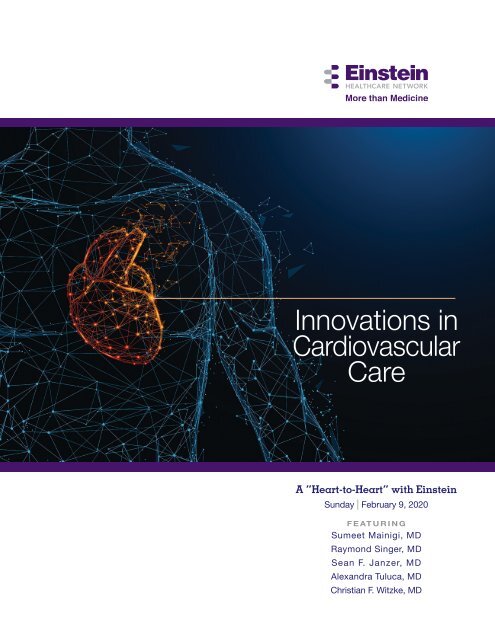
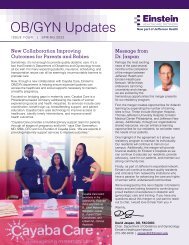
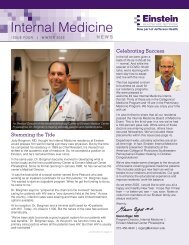
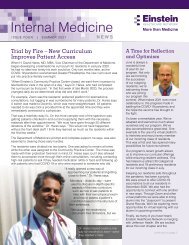
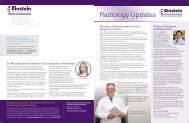

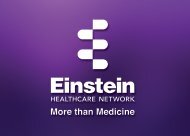
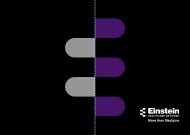
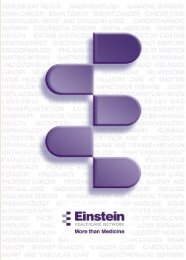
![Donor_Impact_Report_2019[1]](https://img.yumpu.com/65872065/1/186x260/donor-impact-report-20191.jpg?quality=85)



